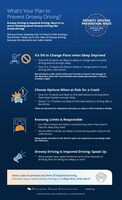Young People More Likely To Drive Drowsy
National Sleep Foundation's Drowsy Driving Prevention Week® Provides Tips to Prevent One in Six Traffic Fatalities
WASHINGTON, Nov. 9, 2012 /PRNewswire-USNewswire/ -- In recognition of Drowsy Driving Prevention Week®, (November 12-18), the National Sleep Foundation is joining with the AAA Foundation for Traffic Safety to educate drivers about sleep safety. A recent survey conducted by the AAA Foundation found that young people are more likely to drive drowsy. Specifically, one in seven licensed drivers ages 16-24 admitted to having nodded off at least once while driving in the past year as compared to one in ten of all licensed drivers who confessed to falling asleep during the same period.
A recent National Sleep Foundation poll found that teens and adults in their twenties reported less sleep satisfaction and roughly one in five rated as "sleepy" on a standard clinical assessment tool that determines whether sleepiness impairs daily activities.
"Young Americans are sleepy, and this affects their health and safety," says David Cloud, CEO of the National Sleep Foundation. "It's important to get the word out that it's dangerous to drive drowsy. This could save thousands of lives."
Using an analysis of previous data, the AAA Foundation estimates that about one in six deadly crashes involves a drowsy driver. The National Sleep Foundation's 2011 Sleep in America poll found that among those who drove, about one-half (52%) indicated that they have driven drowsy, with more than one-third (37%) doing so in the past month.
Sleepiness can impair drivers by causing slower reaction times, vision impairment, lapses in judgment and delays in processing information. In fact, studies show that being awake for more than 20 hours results in an impairment equal to a blood alcohol concentration of 0.08%, the legal limit in all states. It is also possible to fall into a 3-4 second microsleep without realizing it.
Feeling sleepy? Stop driving if you exhibit these warning signs.
The following warning signs indicate that it's time to stop driving and find a safe place to pull over and address your condition:
- Difficulty focusing, frequent blinking and/or heavy eyelids
- Difficulty keeping reveries or daydreams at bay
- Trouble keeping your head up
- Drifting from your lane, swerving, tailgating and/or hitting rumble strips
- Inability to clearly remember the last few miles driven
- Missing exits or traffic signs
- Yawning repeatedly
- Feeling restless, irritable, or aggressive.
Here's what you can do to prevent a fall-asleep crash:
- Get a good night's sleep before you hit the road. You'll want to be alert for the drive, so be sure to get adequate sleep (seven to nine hours) the night before you go.
- Don't be too rushed to arrive at your destination. Many drivers try to maximize the holiday weekend by driving at night or without stopping for breaks. It's better to allow the time to drive alert and arrive alive.
- Use the buddy system. Just as you should not swim alone, avoid driving alone for long distances. A buddy who remains awake for the journey can take a turn behind the wheel and help identify the warning signs of fatigue.
- Take a break every 100 miles or 2 hours. Do something to refresh yourself like getting a snack, switching drivers, or going for a run.
- Take a nap—find a safe place to take a 15 to 20-minute nap, if you think you might fall asleep. Be cautious about excessive drowsiness after waking up.
- Avoid alcohol and medications that cause drowsiness as a side-effect.
- Avoid driving at times when you would normally be asleep.
- Consume caffeine. The equivalent of two cups of coffee can increase alertness for several hours.
For more information about drowsy driving, visit the National Sleep Foundation's drowsy driving website at www.DrowsyDriving.org.
Drowsy Driving Prevention Week®
In an effort to reduce the number of fatigue-related crashes and to save lives, the National Sleep Foundation is declaring November 12-18, 2012 to be Drowsy Driving Prevention Week®. This annual campaign provides public education about the under-reported risks of driving while drowsy and countermeasures to improve safety on the road.
About the National Sleep Foundation
The National Sleep Foundation is dedicated to improving sleep health and safety through education, public awareness and advocacy. It is well-known for its annual Sleep in America poll. The Foundation is a charitable, educational and scientific not-for-profit organization located in Washington, DC. Its membership includes researchers and clinicians focused on sleep medicine, professionals in the health, medical and science fields, individuals, patients, families affected by drowsy driving and more than 900 healthcare facilities throughout North America. Please visit www.sleepfoundation.org for more information.
SOURCE National Sleep Foundation
WANT YOUR COMPANY'S NEWS FEATURED ON PRNEWSWIRE.COM?
Newsrooms &
Influencers
Digital Media
Outlets
Journalists
Opted In





Share this article